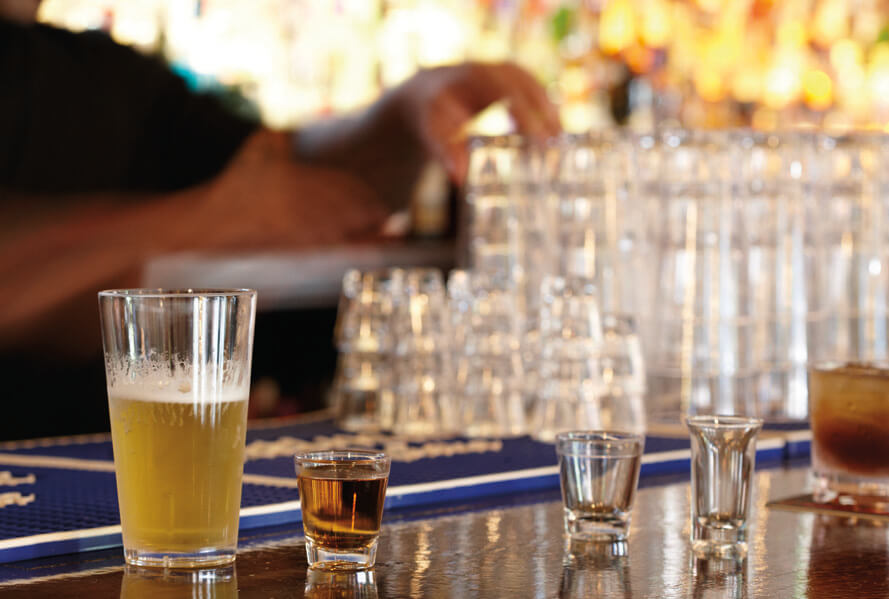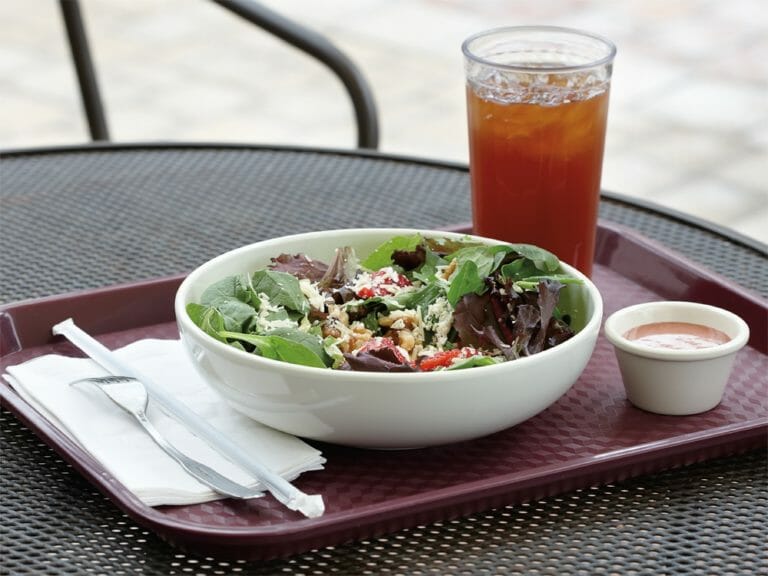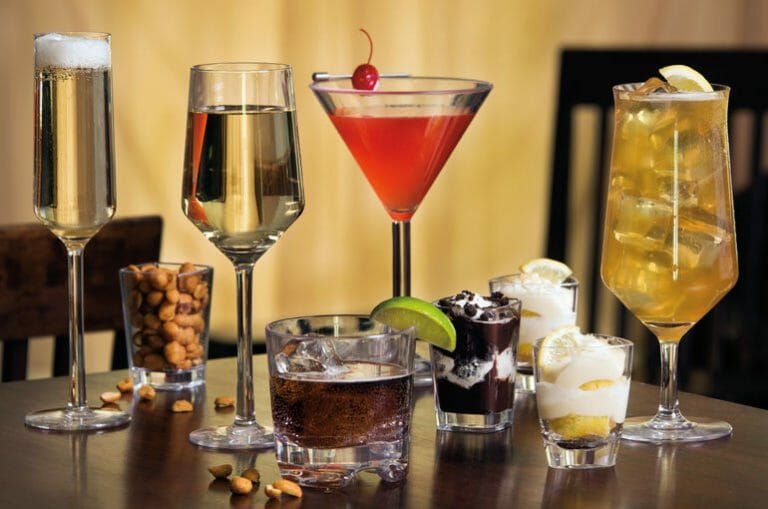Plastic vs. Glass Drinkware for Commercial Foodservice: Which is Better?
From intimate dining rooms to service for thousands, every foodservice establishment needs beverage service to accompany their menu. Drinks can be as commonplace as tea and water or as complex as craft cocktails. Regardless of your beverage service style, you can’t serve drinks without drinkware.
But do you go with plastic or glass? These days plastic drinkware often looks just as sharp, shiny, and clear as their glass counterparts. And it’s super easy to add custom branded logos and designs to plastic drinkware. So how do you choose?
Both excellent choices, these two materials can impact service flow and your bottom line in different ways. We’re going to take a look at plastic and glass drinkware to see how they stack up. We’ll cover a few key areas that can have the most impact on foodservice operations: costs, aesthetics, and broken glass’ affect on operations.
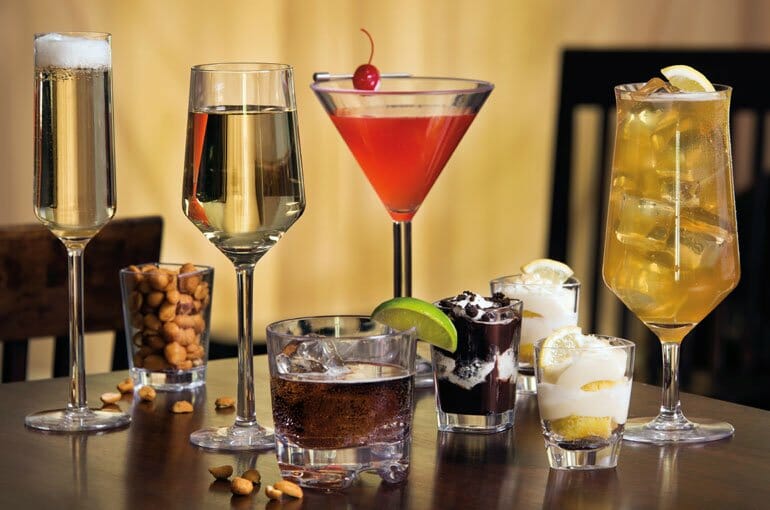
Pictured: Viaª Plastic Barware, Roc N’ Rollª Plastic Rocks, Plastic Martini, and Plastic Petite Dessert Shooters.
Cost of Plastic vs. Glass Drinkware for Foodservice
Foodservice’s notoriously tight margins seem to get even tighter every day with increasing labor costs and challenging competitive landscapes. Operators have plenty of reasons to keep a close eye on their costs and find savings where they can.
The upfront cost of plastic vs. glass drinkware can vary depending on the volume purchased or the style chosen. One isn’t always more expensive than the other. But plastic drinkware’s replacement rate is much lower than glass, which is where operators will find substantial savings in the long run.
Plastic drinkware’s service life far outlasts that of glass drinkware due its superior durability, especially if you follow prescribed care and maintenance. According to an Eastman-Kodak study, some kinds of plastic drinkware can withstand at least 1,000 washes in a commercial dishwasher before showing signs of wear. And that’s in addition to generally being able to stand up to bustling, high-volume kitchen environments.
Glass drinkware can obviously stand up to plenty of dish washing. But how much good that does is up for debate considering a little nudge in the wrong direction, or mishandling by staff can cause glass drinkware to shatter, taking it out of service immediately. Plastic drinkware, however, often recovers from such accidents, which are just part of life in a high-volume kitchen.
Even though it’s possible to spend more on an initial order of plastic drinkware than glass, the low replacement rate compared to glass absolutely saves money over time. Glass drinkware is replaced at 50%-200% annually compared to plastic drinkware’s replacement rate of 10%-20%, creating a substantial cost difference between the two materials.
Aesthetics of Plastic vs. Glass Drinkware for Foodservice
Thanks to advances in modern design and manufacturing, foodservice operators now have more choice than ever when it comes to great looking plastic drinkware. If you saw a high-end plastic champaign flute next to one made of glass, we’d be willing to bet that you’d have to touch one to figure out which material it’s made from.
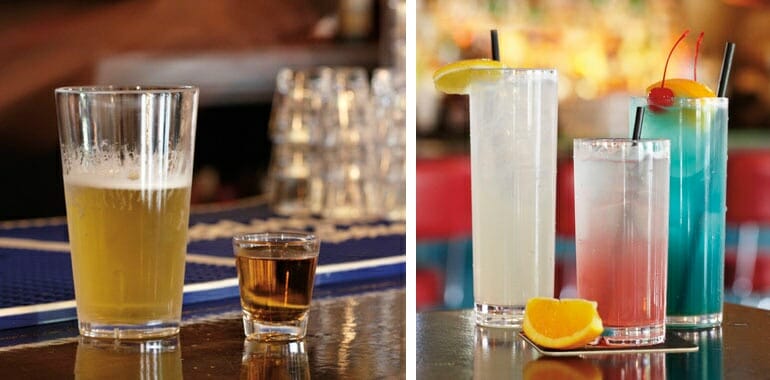
Pictured on Left: 16 oz. Plastic Beer Glass/Shaker and 1 oz. Shot Glass. Pictured on Right: plastic Tom Collins and High Ball Glasses.
This is good news because operators can get the same refined look to support a range of styles in plastic instead of glass. Popular New American styles like urban industrial, vintage, and farm-to-table brands can now find several plastic drinkware options to fit their positioning. Mason jars, stemless wine glass displays, and beer flight mini taster glasses on a wooden taster flight board come to mind. Some of these modern choices are great for a bar environment with occasionally rowdy guests. Another attractive feature is that most plastic barware can hold a frost longer than glass barware can.
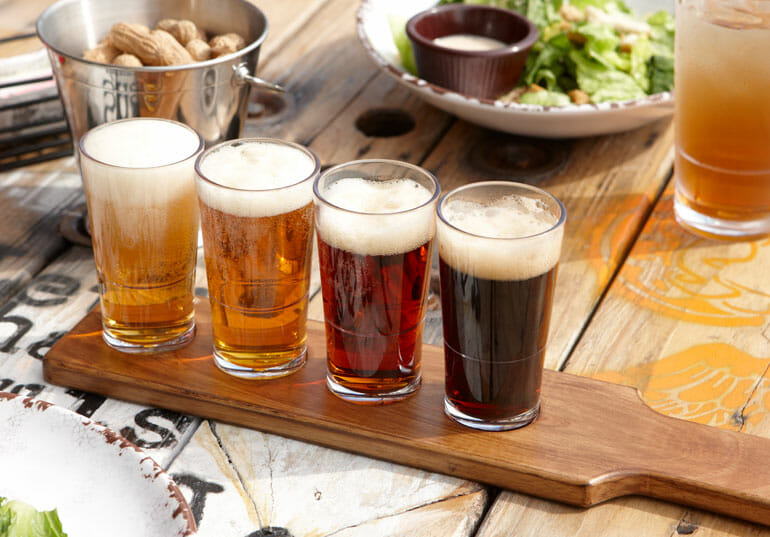
Pictured: Taster Wood Paddle Flight with 5 oz. Plastic Stackable Taster Glass
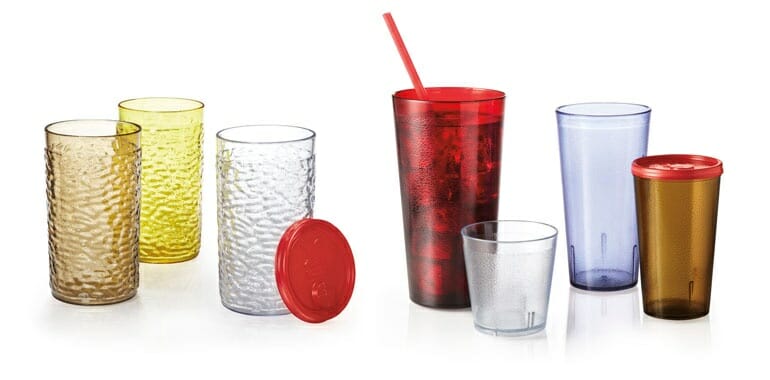
Pictured: 16 oz. Waikiki Plastic Tumblers and Textured Tumblers.
That’s not to say that all plastic drinkware looks like glass, though. There are tried and true styles, popular in very high-volume foodservice like college dining facilities, that are unmistakably plastic and still the preferred choice for many operators.
However, some establishments may just prefer glass drinkware. Are highly rated destination restaurants like Chicago’s Alinea or NYC’s Augustine using plastic drinkware? Probably not. And that’s okay. Glass is a great option that absolutely has its place in foodservice. The point is that operators don’t have to use glass to get a high-end look if they don’t want to thanks to the excellent plastic drinkware designs on the market today.
If you do choose glass drinkware, let’s take a look at some things to consider from the operational side should glass break during service. Depending on a few factors, you could be looking at a quick cleanup or a line-halting situation.
Broken Glass’ Affect on Operations
When it comes to plastic vs. glass drinkware, we know that plastic is more durable than glass. But consider all the ways that broken glass can impact your operation. From the type of flooring influencing how easily or thoroughly glass can be broken or cleaned, to seriously slowing your operations and reducing guest and staff safety, broken glass is just the worst in a foodservice environment.
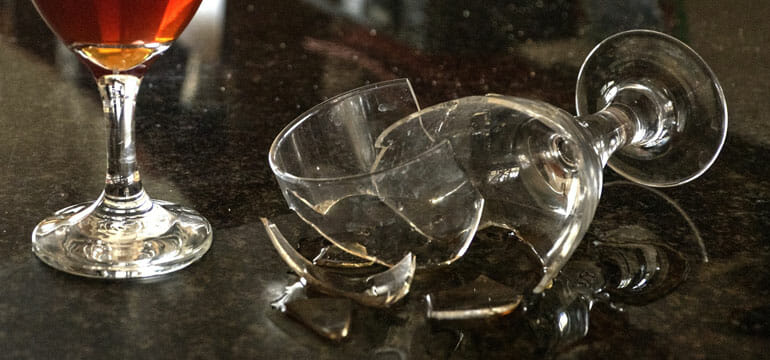
Consider Your Flooring
Carpeted dining rooms don’t pose much of a threat if glass drinkware is dropped. However, carpeting isn’t as popular as it once was. And if you do get broken glass on carpet, it’s so difficult to clean that you can find entire blog posts dedicated to the topic. It can also pose a safety issue for your staff and guests for weeks to come, if not longer.
Wood or wood laminate flooring, which is popular with the urban industrial look, can soften the impact of dropped glass drinkware, reducing the chances for breaking. But shards of glass can get stuck in the wood or wood laminate, potentially leaving unseen specks behind for some poor soul to find later.
Tile and concrete flooring are also popular choices for modern restaurants. We all know what happens if you drop glass drinkware on either of those surfaces: shatter city. However, the glass won’t get stuck in carpet fibers or softer materials like wood or wood laminate, which makes cleaning broken glass on tile and concrete a much easier task.
While plastic drinkware can break, chip, or crack, it doesn’t shatter regardless of which surface it’s dropped on. In a high-volume foodservice environment where staff often move around quickly in tight quarters, it’s only natural for things to get bumped and dropped here and there. Using plastic drinkware greatly reduces the risk of a simple run-in halting operations to clean up broken glass.
Patio/Poolside Service
This one is probably a given considering that most places with poolside or patio service don’t even allow glass in these areas. But for good reason, so we’ll go ahead and make a quick mention of it here, too. Patios and poolsides are full of barefoot people out to have a good time. High-end hotels capitalize on this tradition during the summer months with poolside cabanas complete with full-service wait staff.
Using stylish plastic drinkware designs, hoteliers can uphold their luxury brand positioning while still providing a safe, comfortable environment for guests. Never mind the assurance that comes with knowing they’ll never have to drain a pool or close down a patio area due to broken glass, upsetting guests left and right.
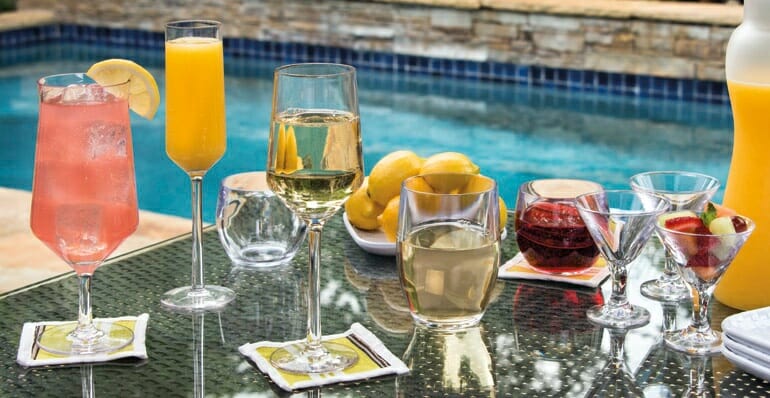 Pictured: Viaª Plastic Barware, Plastic Stemless Wine Glasses, and 3 oz. Plastic Mini Martinis.
Pictured: Viaª Plastic Barware, Plastic Stemless Wine Glasses, and 3 oz. Plastic Mini Martinis.
Broken Glass can put You in the Weeds
No foodservice operator wants to deal with broken glass because it’s a safety issue (food and otherwise), can be very difficult to thoroughly clean, and heaven forbid broken glass gets into the ice bin during a busy shift. Having to “burn ice,” a common term for melting/removing ice from a bin when it’s been compromised by broken glass, is a huge pain, and it can put your whole staff in the weeds.
If a staff member is injured from broken glass during a shift, not only might you face workers’ compensation expenses, you may be short an employee if they’re hurt badly enough to have to go to the E.R. or need to take a day or two off to heal. All foodservice operators have worked an understaffed shift at some point their careers, and they’d agree with us that operations run much more efficiently under a full staff.
Your guests can have the same issue if they come into contact with broken glass. What’s more likely, however, is that a guest may cut their lip on a chipped rim, creating a less than pleasant dining experience and potentially a bad reputation for your brand.
Further, if glass drinkware is dropped and broken, it’s obviously taken out of rotation. Eventually, operators will need to replace these pieces, which costs money, which impacts your bottom line. While you should definitely avoid dropping plastic drinkware for the sake of getting the best service life out of your pieces, doing so doesn’t always mean you’ll have to retire that piece right away.
Thermal Shock
Another lookout for glass drinkware is thermal shock. Thermal shock happens when an item is rapidly heated then cooled, or vice versa, which causes the material to expand and contract just as rapidly. If hot glassware is taken straight from the dish pit after being washed and then filled with ice and a beverage, it may shatter in your server’s hand.
Plastic drinkware is affected by thermal shock as well, but it only results in crazing, which is the development of hairline fractures in plastic. Crazing has a negative affect on plastic drinkware’s clarity and overall look, but it’s not dangerous and it can be managed through good care and maintenance.
Stackable
Plastic glasses are easily stackable, which saves much needed room at bars and in kitchen areas. With their light weight, it’s no big deal for a staff member to bring a tall stack of glasses from the dish area to the bar, creating operational efficiencies. If that stack of plastic drinkware gets dropped, sure, it’ll draw some attention and you’ll have to round up all the cups, but there won’t be shattered glass everywhere.
Some glass drinkware is stackable, but you’d be ill advised to stack them tall and carry them around a busy foodservice establishment. For one, a tall stack of glass drinkware would be pretty heavy and much more prone to being dropped than plastic. But more importantly, if a tall stack of glass drinkware gets dropped, not only is that going to be an expensive mistake, it puts your staff and guests in danger because a large amount of broken glass may shatter over a wide area. On top of that, it’s difficult to thoroughly clean such a mess and you may be finding shards for weeks to come.
Even if you don’t stack your drinkware at your foodservice operation, many folks use compartmentalized drinkware racks stacked on top of each other, placed on a dolly so it can be easily moved around the kitchen. If a staff member is pushing, instead of pulling a set of stacked drinkware racks and the whole thing topples over, our hearts go out to you. We’ve seen this kind of thing happen before and it’s as messy as it is dangerous and expensive.
BONUS SAFETY PRO TIP: If your operation stacks glass drinkware in racks and moves them around on a dolly, always pull the dolly behind you. Never push it in front of you. This is the most effective way to avoid toppling over several pounds of glass drinkware.
Like we said, both plastic and glass drinkware have their respective places in foodservice. But with so many elegant, durable, safe, and cost-saving options in plastic drinkware these days, we’re excited that foodservice operators can now benefit from all that plastic drinkware has to offer. To learn about keeping your plastic drinkware looking shiny and new, check out “4 Easy Steps to Extend Plastic Drinkware’s Service Life.” You’ll be glad you did.
{{cta(‘8d97949d-5da3-4d20-be7d-c81134328a61’)}}

